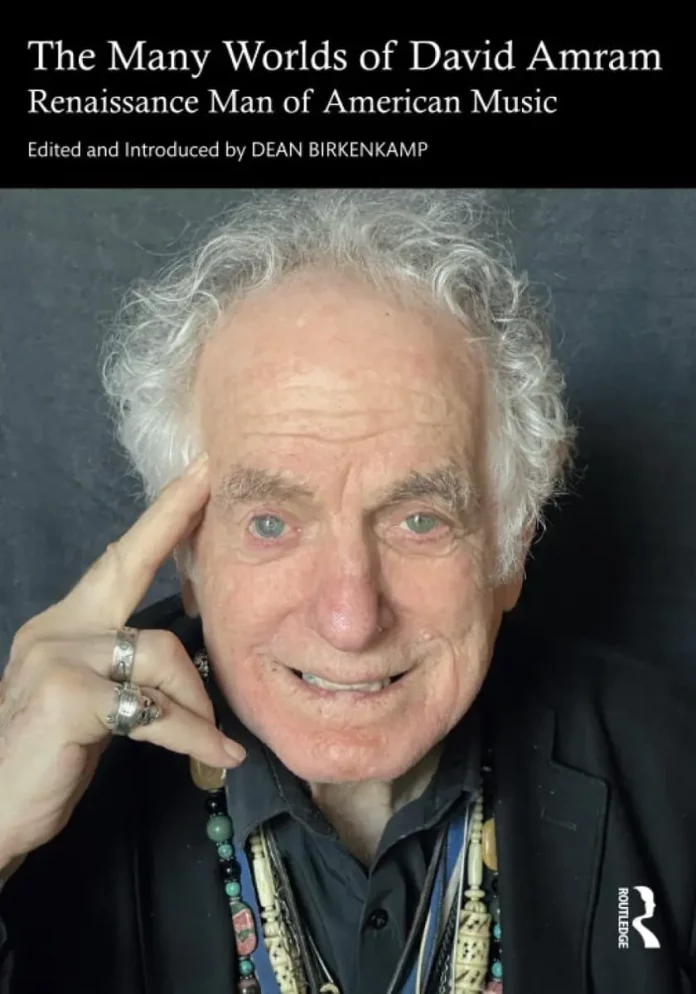David Amram will be 94 this year, and the term “renaissance man” does not do him justice. His levels of energy and enthusiasm are unbelievable: in July 2023, when I communicated with him regarding some research I was doing, he told me “I am in REALLY HOT Oklahoma, doing gigs in Oklahoma City, Okema and then one in Tulsa. It’s quite a change of pace, after nearly drowning riding through the very centre of the recent storm and ensuing floods…” In answering my query, he was able to tell me that the alto sax player on the soundtrack of the film Pull My Daisy (1959) was Sahib Shihab. Amram wrote the music and appeared in the film with Jack Kerouac, Allen Ginsberg and Gregory Corso.
Renaissance Man Of American Music, edited by Dean Birkenkamp, covers every aspect of the career of David Amram, who was born 17 November 1930. Individual chapters describe his concert-hall compositions, his chamber music, his work for opera, theatre and cinema soundtracks, and his involvement, both as a performer and composer, in jazz. Undoubtedly, the latter will be of most interest to readers of Jazz Journal. Amram studied at Oberlin Conservatory of Music and George Washington University, and became adept on piano and French horn. His jazz work is covered in the book in an interview with Marc Myers.
In 1951 in Washington, Amram was host to many musicians in his apartment, including Dizzy Gillespie and Charlie Parker: the latter ate borscht and sour cream and dumplings and “looked like a farmer that night … Very friendly and warm.” After army service, Amram found himself in 1955 in Paris, and recorded with Lionel Hampton, Nat Adderley and Benny Bailey, and later with Bobby Jaspar. He returned to the USA, and in New York was introduced by Leonard Feather to Charles Mingus, with whom he played at the Café Bohemia. Amram’s next assignment was with Oscar Pettiford’s big band, and then he moved into composing for theatre and cinema productions. The latter included Splendor In The Grass (1960), The Young Savages (1961), The Manchurian Candidate (1962) and The Arrangement (1969). Premiered in 1971 at New York’s Lincoln Centre, Amram’s Triple Concerto for Woodwind, Brass, Jazz Quintets and Orchestra was a classic piece of Third Stream music featuring members of his group including Jerry Dodgion on alto sax and Pepper Adams on baritone sax, and the American Symphony Orchestra.
Dean Birkenkamp, a senior editor with Routledge Publishers, in his introduction to Renaissance Man Of American Music, says “While any lay reader can enjoy the book, it also can be assigned for reading in classrooms, in music composition, performance studies, Beat studies, theatre, American studies, multicultural arts, and more. Some college courses have in recent years named a course after the title of Amram’s 1971 double album No More Walls, issued by RCA records.”
“No More Walls” is a phrase that sums up the life and work of David Amram, and this book will be a surprise to those readers who only know him for his jazz and film work. He covers not only the whole of American but also world culture.
The Many Worlds Of David Amram: Renaissance Man Of American Music, edited and introduced by Dean Birkenkamp. 2024; 322 pp; pb; 16 c photos, 22 b/w photos. US: Routledge, US$ 48.95, ISBN 9781032290300. UK: Routledge, £35.99, ISBN 9781032290300
















